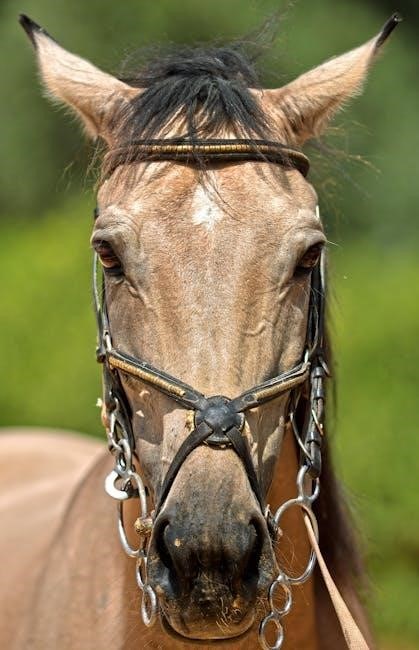Horse bits are essential tools for communication between a horse and rider, designed to guide the horse’s movement and responsiveness. Understanding their design and function is crucial for effective training and ensuring the horse’s comfort. With various types available, selecting the right bit is vital for clear communication and optimal performance.
Understanding the Importance of Bits in Horse Communication
Horse bits are vital for clear and effective communication between the rider and the horse. They translate the rider’s cues into pressure points that guide the horse’s movement and behavior. A bit acts as a bridge, allowing the rider to convey commands while enabling the horse to respond accurately. Proper bit selection ensures the horse understands the signals without discomfort, fostering trust and cooperation. Miscommunication can occur if the bit is ill-fitting or inappropriate, leading to confusion or resistance. Thus, understanding bit mechanics is essential for harmonious horse-rider interaction and achieving desired performance.

Types of Horse Bits
Horse bits come in various types, such as snaffle and curb bits, designed for different training levels and horse needs, with materials ranging from stainless steel to rubber.
Snaffle Bits
Snaffle bits are the most common type of horse bit, ideal for young or sensitive horses. They work by applying direct pressure to the horse’s mouth, with no leverage, making them gentle and effective for basic training. Available in jointed or straight mouthpieces, snaffle bits encourage clear communication and responsiveness. The jointed design allows for independent action on each side of the mouth, while straight bars provide a firmer feel. Snaffle bits are popular for their simplicity and versatility, suitable for a wide range of disciplines and training levels, ensuring comfort and clarity in horse-rider communication.
Curb Bits
Curb bits are designed for more advanced training and use leverage to apply pressure to the horse’s mouth, chin, and poll. They feature a curb chain that enhances the bit’s action, making them suitable for horses that require stronger cues. Curb bits are often used in disciplines like Western riding or for horses that are more experienced. The bit’s effectiveness relies on proper fitting and use, as improper tension can cause discomfort. Curb bits are versatile but should be used with caution, ensuring the horse is trained to respond appropriately to the increased pressure points.
Pelham Bits
Pelham bits combine elements of both snaffle and curb bits, offering dual action through two rings. They apply pressure to the horse’s mouth, poll, and chin, making them effective for strong or inattentive horses. The bit’s design allows riders to use either direct or leveraged pressure, providing versatility. Pelham bits are often used for horses that require clear guidance and are popular in disciplines like show jumping and eventing. They suit experienced riders who can handle the nuanced control they offer. Proper fitting is essential to ensure comfort and avoid discomfort for the horse.
Mullen Mouth Bits
Mullen mouth bits feature a smooth, continuous mouthpiece without joints, designed to distribute pressure evenly across the horse’s mouth. They are ideal for sensitive horses or those with a tender mouth, as they provide a gentle, consistent feel. Available in materials like stainless steel, copper, or rubber, these bits promote a relaxed jaw and clear communication. Mullen mouth bits are often recommended for young or inexperienced horses, as they offer a mild and forgiving action. Proper sizing and fitting are essential to ensure comfort and effectiveness, making them a great introductory bit for many horses.
How to Choose the Right Bit for Your Horse
Choosing the right bit involves considering your horse’s age, breed, training level, and sensitivity. Selecting a bit that suits their needs ensures comfort and clear communication, enhancing performance and trust between horse and rider.
Factors to Consider: Horse’s Age, Breed, and Training Level
When selecting a bit, consider your horse’s age, breed, and training level. Younger horses or those in early training often benefit from milder bits, such as snaffle or mullen mouth bits, to avoid discomfort. Certain breeds may have specific mouth shapes or sizes that require tailored bits. Horses with higher training levels or those engaged in advanced disciplines may require more specialized bits, like curb bits, to refine communication. Matching the bit to these factors ensures comfort, effectiveness, and promotes a positive response from the horse.

Bit Sizing and Fit
Proper bit sizing and fit are crucial for your horse’s comfort and performance. Measure the horse’s mouth to ensure the bit isn’t too tight or loose, avoiding discomfort or resistance. Ill-fitting bits can cause pain and behavioral issues, so regular checks and adjustments are essential. Always seek professional guidance to ensure the best fit for your horse’s specific needs.
Measuring Your Horse for the Correct Bit Size
To ensure a proper fit, measure your horse’s mouth width by placing a bit or a bit sizer inside the mouth, resting it on the bars. The bit should sit comfortably, leaving about 1/4 inch of space on each side to prevent pinching. Consider the horse’s breed, age, and dental structure, as some may require a narrower or wider bit. Use a bit sizer tool or consult a professional to determine the ideal size. Proper measurement ensures optimal comfort and effective communication between the horse and rider, avoiding discomfort or resistance during training or riding.

Materials Used in Horse Bits
Horse bits are crafted from materials like stainless steel, copper, rubber, and sweet iron, each offering unique benefits; Stainless steel is durable, copper promotes salivation, rubber is gentle, and sweet iron encourages acceptance.
Stainless Steel, Copper, Rubber, and Sweet Iron Bits
Horse bits are made from various materials, each offering distinct advantages. Stainless steel bits are durable, rust-resistant, and easy to clean, making them a popular choice. Copper bits are known for their ability to promote salivation, creating a softer mouth and improving responsiveness. Rubber bits are gentle and flexible, ideal for sensitive horses. Sweet iron bits are favored for their taste and ability to encourage acceptance, as they oxidize naturally in the horse’s mouth. Choosing the right material ensures comfort, effectiveness, and a positive experience for both the horse and rider.
Bit Action and Pressure Points
Horse bits apply pressure to specific areas in the horse’s mouth, such as the bars, tongue, and lips, to communicate cues. The action determines how pressure is distributed, influencing the horse’s response and movement. Understanding the mechanics ensures effective communication and comfortable control for the horse.
Understanding the Mechanics of Bit Action
A bit works by applying pressure to specific areas in the horse’s mouth, such as the tongue, bars, and lips, to communicate cues. The design of the bit determines how and where pressure is applied. For example, a snaffle bit acts directly on the bars and tongue, while a curb bit uses leverage to amplify pressure. The mechanics of bit action influence how the horse responds to aids, making it essential to choose a bit that suits the horse’s sensitivity and training level. Proper understanding ensures effective communication and comfort for the horse.
Pairing the Bit with the Right Bridle
Pairing the bit with the right bridle ensures proper fit and communication. The bridle supports the bit’s function, with styles like cheek pieces and headstalls influencing control and comfort.
Matching Your Bit to the Bridle for Optimal Performance
Pairing the right bit with the appropriate bridle ensures optimal performance and comfort for the horse. The bridle’s cheek style, such as loose-ring or eggbutt, affects the bit’s stability and action. For instance, a loose-ring bit may move more freely, while an eggbutt provides fixed cheek pieces for consistent pressure. Riders should consider the horse’s specific needs, training level, and discipline when selecting a bridle to match their bit. Proper alignment and fit are crucial to avoid discomfort and ensure the bit communicates effectively. This harmonious pairing enhances responsiveness, supporting the horse’s well-being and performance.
Common Mistakes in Bit Selection
Common mistakes include choosing the wrong bit type for the horse’s needs, ignoring proper sizing, and not considering the horse’s comfort and training level.
Avoiding Improper Fit and Incorrect Bit Type
Avoiding Improper Fit and Incorrect Bit Type
Improperly fitting bits can cause discomfort, leading to resistance and behavioral issues in horses. Selecting the wrong bit type for a horse’s training level or mouth sensitivity is another common error. Ensuring a proper fit involves measuring the horse’s mouth accurately and choosing materials that promote comfort. A bit that is too tight or too loose can impair communication, while a bit designed for a different discipline may not suit the horse’s needs. Always consult a professional to ensure the bit fits correctly and aligns with the horse’s training and temperament for optimal performance and comfort.

Caring for Your Horse’s Bit
Regular cleaning and polishing maintain the bit’s condition. Store it properly to prevent damage. Ensure it remains free from bacteria for your horse’s comfort and safety.
Cleaning, Maintenance, and Storage Tips
Regularly clean your horse’s bit with mild soap and water to remove dirt and bacteria. Dry thoroughly to prevent rust or corrosion. Store the bit in a dry place, away from direct sunlight, to maintain its condition. Inspect the bit for wear or sharp edges and polish it periodically to ensure smooth action. Avoid using harsh chemicals, as they can damage materials like copper or rubber. Proper care extends the bit’s lifespan and ensures your horse’s comfort and safety. Regular maintenance is essential for optimal performance and longevity of the bit.
